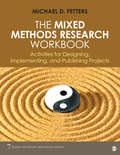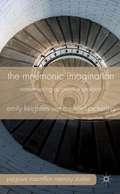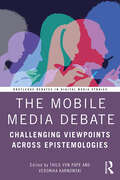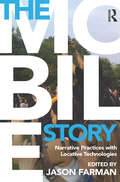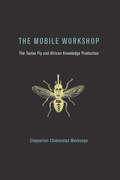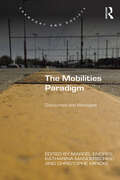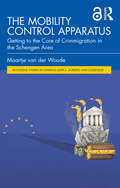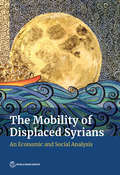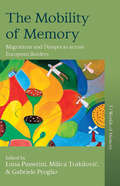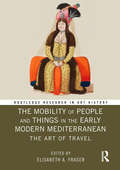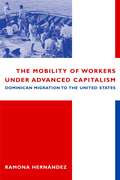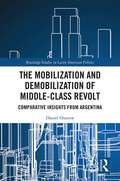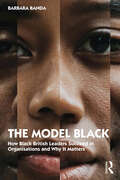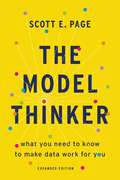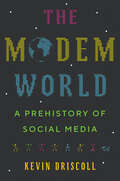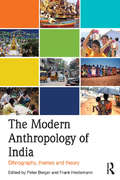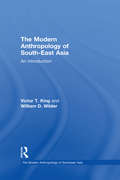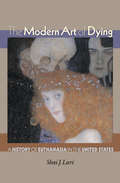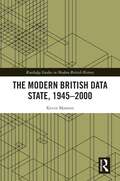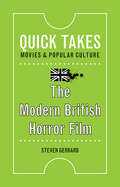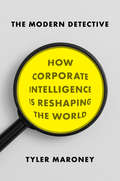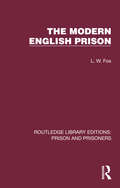- Table View
- List View
The Mixed Methods Research Workbook: Activities for Designing, Implementing, and Publishing Projects (Mixed Methods Research Series #7)
by Michael D. FettersWritten by Michael D. Fetters, one of the leading scholars in the field and co-editor of the Journal of Mixed Methods Research, The Mixed Methods Research Workbook: Activities for Designing, Implementing, and Publishing Projects is the perfect tool for doctoral students and researchers who want support throughout their research project, as well as a practical way to apply the knowledge they’ve learned. With The Mixed Methods Research Workbook, you’ll be ready to tackle your mixed methods research project with confidence. Each chapter follows a familiar framework, starting with learning objectives for each piece of the mixed methods process. Readers have ample space in this text to write notes, fill out activities, and begin their process of actively designing and writing up a mixed methods study. This easy-to follow process gives readers an immediate structure to their projects. Exemplar boxes provide a starting framework, with the text encouraging deeper reflection on mixed methods challenges and opportunities. Stories from the field illuminate struggles and suggestions with the benefit of hindsight. Checklists at the end of each chapter help readers stay organized and key resources provide up-to-date lists of material for further study. From start to finish, readers can follow along with this text as they work on their projects. The text begins by assisting readers in identifying topics and conducting literature reviews in the context of mixed methods, zeroing in to address mixed-methods-specific challenges like integration, leveraging advantages of both qualitative and quantitative methods, and incorporating theory and personal backgrounds. Identifying data sources helps readers organize their data collection. Two chapters on research designs structure the data collection process with procedural diagrams. A unique chapter on mixed methods sampling offers application through basic and advanced designs. The book illustrates integrating and implementing mixed methods designs with practical advice for each of stage of the process. Ethics in a mixed methods context readies readers for the research protocol stage. Several chapters fully explicate the data analysis process, including developing a joint display, a state-of-the-art procedure for analysis and presentation of findings. Closing out the process, the text tackles quality and evaluation in mixed methods studies, preparing your study for publication, and writing up your article.
The Mnemonic Imagination
by Michael Pickering Emily KeightleyAn exploration of some of the key theoretical challenges and conceptual issues facing the emergent field of memory studies, from the relationship between experience and memory to the commercial exploitation of nostalgia, using the key concept of the mnemonic imagination.
The Mobile Media Debate: Challenging Viewpoints Across Epistemologies (Routledge Debates in Digital Media Studies)
by Veronika Karnowski Thilo Von PapeAn accessible, engaging, and timely overview of the key debates surrounding the role of mobile media in today’s society.Edited by Thilo von Pape and Veronika Karnowski, this volume includes contributions from a variety of geographical and disciplinary backgrounds, reflecting the diverse standpoints within the field of mobile media and communication. The collection explores perspectives from the micro-level of individual or small group appropriation of mobile media, to the uses and effects among larger communities, public spaces, and societies at large. The chapters address individual uses and effects of mobile media, such as problematic smartphone use, news consumption through mobile media, and mobile media as an empowerment tool for entrepreneurs. They also discuss the role of mobile media in private and professional social constellations (phubbing, personal mobile device use at work) and in struggles over personal empowerment, counter-power, and global development. Looking beyond the smartphone, the book also explores underlying infrastructures and emerging technologies such as augmented and virtual reality.This book is a key resource for students and scholars of media and communication, as well as policy-makers and practitioners working in related areas such as media education.
The Mobile Story: Narrative Practices with Locative Technologies
by Jason FarmanWhat happens when stories meet mobile media? In this cutting-edge collection, contributors explore digital storytelling in ways that look beyond the desktop to consider how stories can be told through mobile, locative, and pervasive technologies. This book offers dynamic insights about the new nature of narrative in the age of mobile media, studying digital stories that are site-specific, context-aware, and involve the reader in fascinating ways. Addressing important topics for scholars, students, and designers alike, this collection investigates the crucial questions for this emerging area of storytelling and electronic literature. Topics covered include the histories of site-specific narratives, issues in design and practice, space and mapping, mobile games, narrative interfaces, and the interplay between memory, history, and community.
The Mobile Workshop: The Tsetse Fly and African Knowledge Production (The\mit Press Ser.)
by Clapperton Chakanets MavhungaHow the presence of the tsetse fly turned the African forest into an open laboratory where African knowledge formed the basis of colonial tsetse control policies.The tsetse fly is a pan-African insect that bites an infective forest animal and ingests blood filled with invisible parasites, which it carries and transmits into cattle and people as it bites them, leading to n'gana (animal trypanosomiasis) and sleeping sickness. In The Mobile Workshop, Clapperton Chakanetsa Mavhunga examines how the presence of the tsetse fly turned the forests of Zimbabwe and southern Africa into an open laboratory where African knowledge formed the basis of colonial tsetse control policies. He traces the pestiferous work that an indefatigable, mobile insect does through its movements, and the work done by humans to control it.Mavhunga's account restores the central role not just of African labor but of African intellect in the production of knowledge about the tsetse fly. He describes how European colonizers built on and beyond this knowledge toward destructive and toxic methods, including cutting down entire forests, forced “prophylactic” resettlement, massive destruction of wild animals, and extensive spraying of organochlorine pesticides. Throughout, Mavhunga uses African terms to describe the African experience, taking vernacular concepts as starting points in writing a narrative of ruzivo (knowledge) rather than viewing Africa through foreign keywords. The tsetse fly became a site of knowledge production—a mobile workshop of pestilence.
The Mobilities Paradigm: Discourses and Ideologies (Transport and Society)
by Katharina Manderscheid Marcel Endres Christophe MinckeOver the last two decades, the conceptualisation and empirical analysis of mobilities of people, objects and symbols has become an important strand of social science. Yet, the increasing importance of mobilities in all parts of the social does not only happen as observable practices in the material world but also takes place against the background of changing discourses, scientific theories and conceptualisations and knowledge. Within the formation of these mobilities discourses, the social sciences constitute a relevant actor. Focussing on mobility as an object of knowledge from a Foucauldian perspective rather than a given entity within the historical contingency of movement, this book asks: How do discourses and ideologies structure the normative substance, social meanings, and the lived reality of mobilities? What are the real world effects of/on the will and the ability to be mobile? And, how do these lived realities, in turn, invigorate or interfere with certain discourses and ideologies of mobility?
The Mobilities of Ships
by Anyaa Anim-Addo, William Hasty and Kimberley PetersWe live in a world that is ever on the move, as is increasingly recognised within research on mobilities. Yet studies of mobility have failed to ‘go to sea’ with the same enthusiasm as mobilities ashore. When we consider mobility, we most often examine those movements that evidently form part of our everyday lives. We forget to look outwards to the sea. Yet ships have played – and continue to play – a significant role in shaping socio-cultural, political and economic life. This book turns our attention to the manifold mobilities that occur at sea through an exploration of the mobilities of ships themselves as well as the movements of objects, subjects and ideas that are mobilised by ships. The Mobilities of Ships brings together seven chapters that tack through unexplored waters and move between diverse case studies, including pirate ships, naval vessels and luxury yachts. In so doing, The Mobilities of Ships offers a rich insight into the world of shipping mobilities past and present.This book was published as a special issue of Mobilities.
The Mobility Control Apparatus: Getting to the Core of Crimmigration in the Schengen Area (Routledge Studies in Criminal Justice, Borders and Citizenship)
by Maartje van der WoudeThis book critically explores the complexities of intra-Schengen border control and migration dynamics within Europe. It provides a comprehensive analysis of how various actors, including border officials and state apparatuses, interact in managing mobility and enforcing controls. The theoretical foundation draws on Foucault’s concept of the dispositif, examining how borders are enforced through a combination of legal frameworks, discourses, and on-the-ground practices.The book emphasises the importance of discretion in border control, arguing that it plays a pivotal role in shaping decisions at both the organisational and street levels. It delves into the experiences of Dutch border control officers and the wider European context, offering a comparative analysis of Europe’s intra-Schengen borderlands. By drawing on real-world case studies, it showcases the tensions between security and mobility and how migration is managed through both visible and covert policing practices. The work is grounded in rich qualitative data, collected over years of fieldwork, and addresses key debates in migration and criminology studies, particularly the evolving concept of ‘crimmigration’ and its implications for human rights and security policies.This book will be of interest to criminologists, sociologists, legal scholars, and political scientists alike, as well as all those engaged in studies on migration, mobility, and the European Union.The Open Access version of this book, available at http://www.taylorfrancis.com, has been made available under a Creative Commons [Attribution-Non Commercial-No Derivatives (CC-BY-NC-ND)] 4.0 license.
The Mobility of Displaced Syrians: An Economic and Social Analysis
by World BankThe war in Syria, now in its eighth year, continues to take its toll on the Syrian people. More than half of the population of Syria remains displaced; 5.6 million persons are registered as refugees outside of the country and another 6.2 million are displaced within Syria's borders. The internally displaced persons include 2 million school-age children; of these, less than half attend school. Another 739,000 Syrian children are out of school in the five neighborhood countries that host Syria's refugees. The loss of human capital is staggering, and it will create permanent hardships for generations of Syrians going forward. Despite the tragic prospects for renewed fighting in certain parts of the country, an overall reduction in armed conflict is possible going forward. However, international experience shows that the absence of fighting is rarely a singular trigger for the return of displaced people. Numerous other factors—including improved security and socioeconomic conditions in origin states, access to property and assets, the availability of key services, and restitution in home areas—play important roles in shaping the scale and composition of the returns. Overall, refugees have their own calculus of return that considers all of these factors and assesses available options. The Mobility of Displaced Syrians: An Economic and Social Analysis sheds light on the 'mobility calculus' of Syrian refugees. While dismissing any policies that imply wrongful practices involving forced repatriation, the study analyzes factors that may be considered by refugees in their own decisions to relocate. It provides a conceptual framework, supported by data and analysis, to facilitate an impartial conversation about refugees and their mobility choices. It also explores the diversified policy toolkit that the international community has available—and the most effective ways in which the toolkit can be adapted—to maximize the well-being of refugees, host countries, and the people in Syria.
The Mobility of Memory: Migrations and Diasporas across European Borders (Worlds of Memory #5)
by Gabriele Proglio Luisa Passerini Milica TrakilovićMigration is most concretely defined by the movement of human bodies, but it leaves indelible traces on everything from individual psychology to major social movements. Drawing on extensive field research, and with a special focus on Italy and the Netherlands, this interdisciplinary volume explores the interrelationship of migration and memory at scales both large and small, ranging across topics that include oral and visual forms of memory, archives, and artistic innovations. By engaging with the complex tensions between roots and routes, minds and bodies, The Mobility of Memory offers an incisive and empirically grounded perspective on a social phenomenon that continues to reshape both Europe and the world.
The Mobility of Memory: Migrations and Diasporas across European Borders (Worlds of Memory #5)
by Gabriele Proglio Luisa Passerini, Milica TrakilovićMigration is most concretely defined by the movement of human bodies, but it leaves indelible traces on everything from individual psychology to major social movements. Drawing on extensive field research, and with a special focus on Italy and the Netherlands, this interdisciplinary volume explores the interrelationship of migration and memory at scales both large and small, ranging across topics that include oral and visual forms of memory, archives, and artistic innovations. By engaging with the complex tensions between roots and routes, minds and bodies, The Mobility of Memory offers an incisive and empirically grounded perspective on a social phenomenon that continues to reshape both Europe and the world.
The Mobility of People and Things in the Early Modern Mediterranean: The Art of Travel (Routledge Research in Art History)
by Elisabeth A. FraserFor centuries artists, diplomats, and merchants served as cultural intermediaries in the Mediterranean. Stationed in port cities and other entrepôts of the Mediterranean, these go-betweens forged intercultural connections even as they negotiated and sometimes promoted cultural misunderstandings. They also moved objects of all kinds across time and space. This volume considers how the mobility of art and material culture is intertwined with greater Mediterranean networks from 1580 to 1880. Contributors see the movement of people and objects as transformational, emphasizing the trajectory of objects over single points of origin, multiplicity over unity, and mutability over stasis.
The Mobility of Workers Under Advanced Capitalism: Dominican Migration to the United States
by Ramona HernándezWhat explains the international mobility of workers from developing to advanced societies? Why do workers move from one region to another? Theoretically, the supply of workers in a given region and the demand for them in another account for the international mobility of laborers. Job seekers from less developed regions migrate to more advanced countries where technological and productive transformations have produced a shortage of laborers. Using the Dominican labor force in New York as a case study, Ramona Hernández challenges this presumption of a straightforward relationship between supply and demand in the job markets of the receiving society. She contends that the traditional correlation between migration and economic progress does not always hold true. Once transplanted in New York City, Hernández shows, Dominicans have faced economic hardship as the result of high levels of unemployment and underemployment and the reality of a changing labor market that increasingly requires workers with skills and training they do not have. Rather than responding to a demand in the labor market, emigration from the Dominican Republic was the result of a de facto government policy encouraging poor and jobless people to leave—a policy in which the United States was an accomplice because the policy suited its economic and political interests in the region.
The Mobilization and Demobilization of Middle-Class Revolt: Comparative Insights from Argentina (Routledge Studies in Latin American Politics)
by Daniel OzarowAdopting Argentina’s popular uprisings against neoliberalism including the 2001-02 rebellion and subsequent mass protests as a case study, The Mobilization and Demobilization of Middle-Class Revolt analyzes two decades of longitudinal research (1995-2018), including World Bank and Latinobarómeter household survey data, along with participant interviews, to explore why nonpolitically active middle-class citizens engage in radical protest movements, and why they eventually demobilize. In particular it asks, how do they become politicized and resist economic and political crises, along with their own hardship? Theoretically informed by Gramsci’s notions of hegemony, ideology and class consciousness, Ozarow posits that to affect profound and lasting social change, multisectoral alliances and sustainable mobilizing vehicles are required to maintain radical progressive movements beyond periods of crisis. With the Argentinian revolt understood to be the ideological forbearer to the autonomist-inspired uprisings which later emerged, comparisons are drawn with experiences in the USA, Spain, Greece UK, Iceland and the Middle East, as well as 1990s contexts in South Africa and Russia. Such a comparative analysis helps understand how contextual factors shape distinctive struggling middle-class citizen responses to external shocks. This book will be of immense value to students, activists and theorists of social change in North America, in Europe and globally.
The Model Black: How Black British Leaders Succeed in Organisations and Why It Matters
by Barbara BandaThis book is for anyone who wants to understand what being more inclusive at work means, especially as it relates to black leaders. It is intended for those people who are saying “I don’t know where to start,” “I don’t know what to do” and “I don’t know what to say” when understanding and talking about race at work. Based on candid interviews with 30 successful black leaders, it peels away the multifaceted layers of black British leaders in organisations to offer a new way of thinking about the black British experience. This book provides the insights and ideas required to have positive conversations about race at work and to create work environments where black leaders can thrive. In identifying the attributes and behaviours that successful black leaders have in common, this book offers new ways of thinking about black people at work that help to further inclusion. It shines a light on the daily reality of being a black leader in the workplace, providing an alternative entry point for conversations around inclusion and explores what individuals and organisations can do to increase inclusion in the workplace. Through first-hand stories this book explores the challenges, compromises, struggles and successes that black people encounter, and the range of strategies they employ to achieve success as they navigate the “white” workplace. It is essential reading for business leaders in the private, public and third sector, human resources professionals, students, anyone teaching or mentoring black students or leaders and everyone interested in understanding race and furthering inclusion in the workplace.
The Model Thinker: What You Need to Know to Make Data Work for You
by Scott E. PageHow anyone can become a data ninja From the stock market to genomics laboratories, census figures to marketing email blasts, we are awash with data. But as anyone who has ever opened up a spreadsheet packed with seemingly infinite lines of data knows, numbers aren't enough: we need to know how to make those numbers talk. In The Model Thinker, social scientist Scott E. Page shows us the mathematical, statistical, and computational models--from linear regression to random walks and far beyond--that can turn anyone into a genius. At the core of the book is Page's "many-model paradigm," which shows the reader how to apply multiple models to organize the data, leading to wiser choices, more accurate predictions, and more robust designs. The Model Thinker provides a toolkit for business people, students, scientists, pollsters, and bloggers to make them better, clearer thinkers, able to leverage data and information to their advantage.
The Modem World: A Prehistory of Social Media
by Kevin DriscollThe untold story about how the internet became social, and why this matters for its future &“A great book for anyone who wants to understand the early days of online communications.&”—Preston Gralla, Arts Fuse Fifteen years before the commercialization of the internet, millions of amateurs across North America created more than 100,000 small-scale computer networks. The people who built and maintained these dial-up bulletin board systems (BBSs) in the 1980s laid the groundwork for millions of others who would bring their lives online in the 1990s and beyond. From ham radio operators to HIV/AIDS activists, these modem enthusiasts developed novel forms of community moderation, governance, and commercialization. The Modem World tells an alternative origin story for social media, centered not in the office parks of Silicon Valley or the meeting rooms of military contractors, but rather on the online communities of hobbyists, activists, and entrepreneurs. Over time, countless social media platforms have appropriated the social and technical innovations of the BBS community. How can these untold stories from the internet&’s past inspire more inclusive visions of its future?
The Modern Anthropology of India: Ethnography, Themes and Theory
by Peter Berger Frank HeidemannThe Modern Anthropology of India is an accessible textbook providing a critical overview of the ethnographic work done in India since 1947. It assesses the history of research in each region and serves as a practical and comprehensive guide to the main themes dealt with by ethnographers. It highlights key analytical concepts and paradigms that came to be of relevance in particular regions in the recent history of research in India, and which possibly gained a pan-Indian or even trans-Indian significance. Structured according to the states of the Indian union, contributors raise several key questions, including: What themes were ethnographers interested in? What are the significant ethnographic contributions? How are peoples, communities and cultural areas represented? How has the ethnographic research in the area developed? Filling a significant gap in the literature, the book is an invaluable resource to students and researchers in the field of Indian anthropology/ethnography, regional anthropology and postcolonial studies. It is also of interest to students of South Asian studies in general as it provides an extensive and critical overview of regionally based ethnographic activity undertaken in India.
The Modern Anthropology of South-East Asia: An Introduction
by Victor King William D. WilderThis is a comprehensive introduction to the social and cultural anthropology of South-East Asia. It provides an overview of the major theoretical issues and themes which have emerged from the engagement of anthropologists with South-East Asian communities; a succinct historical survey and analysis of the peoples and cultures of the region. Most importantly the volume reveals the vitally important role which the study of the area has occupied in the development of the concepts and methods of anthropology: from the perspectives of Edmund Leach to Clifford Geertz, Maurice Freedman to Claude Levi-Strauss; Lauriston Sharp to Melford Spiro.
The Modern Art of Dying: A History of Euthanasia in the United States
by Shai J. LaviHow we die reveals much about how we live. In this provocative book, Shai Lavi traces the history of euthanasia in the United States to show how changing attitudes toward death reflect new and troubling ways of experiencing pain, hope, and freedom. Lavi begins with the historical meaning of euthanasia as signifying an "easeful death." Over time, he shows, the term came to mean a death blessed by the grace of God, and later, medical hastening of death. Lavi illustrates these changes with compelling accounts of changes at the deathbed. He takes us from early nineteenth-century deathbeds governed by religion through the medicalization of death with the physician presiding over the deathbed, to the legalization of physician-assisted suicide. Unlike previous books, which have focused on law and technique as explanations for the rise of euthanasia, this book asks why law and technique have come to play such a central role in the way we die. What is at stake in the modern way of dying is not human progress, but rather a fundamental change in the way we experience life in the face of death, Lavi argues. In attempting to gain control over death, he maintains, we may unintentionally have ceded control to policy makers and bio-scientific enterprises.
The Modern British Data State, 1945-2000 (Routledge Studies in Modern British History)
by Kevin MantonThis political history studies the phenomenal growth of the modern British state’s interest in collecting, collating and deploying population data. It dates this biopolitical data turn in British politics to the arrival of the Labour government in 1964. It analyses government’s increased desire to know the population, the impact this has had on British political culture and the institutions and systems introduced or modified to achieve this. It probes the political struggles around these initiatives to show that despite setbacks along the way and regardless of party, all British governments since the mid-1960s have accepted that data is the key to modern politics and have pursued it relentlessly.
The Modern British Horror Film (Quick Takes: Movies and Popular Culture)
by Steven GerrardWhen you think of British horror films, you might picture the classic Hammer Horror movies, with Christopher Lee, Peter Cushing, and blood in lurid technicolor. Yet British horror has undergone an astonishing change and resurgence in the twenty-first century, with films that capture instead the anxieties of post-Millennial viewers. Tracking the revitalization of the British horror film industry over the past two decades, media expert Steven Gerrard also investigates why audiences have flocked to these movies. To answer that question, he focuses on three major trends: “hoodie horror” movies responding to fears about Britain’s urban youth culture; “great outdoors” films where Britain’s forests, caves, and coasts comprise a terrifying psychogeography; and psychological horror movies in which the monster already lurks within us. Offering in-depth analysis of numerous films, including The Descent, Outpost, and The Woman in Black, this book takes readers on a lively tour of the genre’s highlights, while provocatively exploring how these films reflect viewers’ gravest fears about the state of the nation. Whether you are a horror buff, an Anglophile, or an Anglophobe, The Modern British Horror Film is sure to be a thrilling read.
The Modern Cook: A Practical Guide to the Culinary Art in All Its Branches
by Charles Elme FrancatelliPupil of the great Careme, Chief Cook to Queen Victoria, Charles Elme Francatelli here presents his most celebrated recipes. Crayfish ragout, soles a la marechale, roast turkey, artichokes with butter sauce, summer sandwiches, and countless pies and cakes are among the hundreds of recipes included. Complete dinner menus allow cooks to plan exquisite meals with ease, while detailed instructions (penned in 1846) need only slight adaptation to the modem kitchen.
The Modern Detective: How Corporate Intelligence Is Reshaping the World
by Tyler MaroneyA fascinating examination of the world of private investigators by a 21st-century private eye.Today's world is complicated: companies are becoming more powerful than nations, the lines between public and corporate institutions grow murkier, and the internet is shredding our privacy. To combat these onslaughts, people everywhere -- rich and not so rich, in business and in their personal lives -- are turning away from traditional police, lawyers, and government regulators toward a new champion: the private investigator.As a private investigator, Tyler Maroney has traveled the globe, overseeing sensitive investigations and untying complicated cases for a wide array of clients. In his new book, he shows that it's private eyes who today are being called upon to catch corrupt politicians, track down international embezzlers, and mine reams of data to reveal which CEOs are lying. The tools Maroney and other private investigators use are a mix of the traditional and the cutting edge, from old phone records to computer forensics to solid (and often inspired) street-level investigative work. The most useful assets private investigators have, Maroney has found, are their resourcefulness and their creativity.Each of the investigations Maroney explores in this book highlights an individual case and the people involved in it, and in each account he explains how the transgressors were caught and what lessons can be learned from it. Whether the clients are a Middle Eastern billionaire whose employees stole millions from him, the director of a private equity firm wanting a background check on a potential hire (a known convicted felon), or creditors of a wealthy American investor trying to recoup their money after he fled the country to avoid bankruptcy, all of them hired private investigators to solve problems the authorities either can't or won't touch. In an era when it's both easier and more difficult than ever to disappear after a crime is committed, it's the modern detective people are turning to for help, for revenge, and for justice.
The Modern English Prison (Routledge Library Editions: Prison and Prisoners)
by L. W. FoxOriginally published in 1934, The Modern English Prison was prepared in the belief that among the growing literature of crime and the treatment of crime, there should be some room for some account of the English prison system as it stood. Its first aim was to give an objective and comprehensive view of the system as it was at the time, rather than as it had been or ought to have been: the historical matter is therefore limited to what is necessary for proper understanding of present practice and no attempt is made to trespass on the ground of the penologist. Here is an authoritative and up-to-date account of the Prison System in England and Wales, prepared with the approval of the Prison Commissioners.
